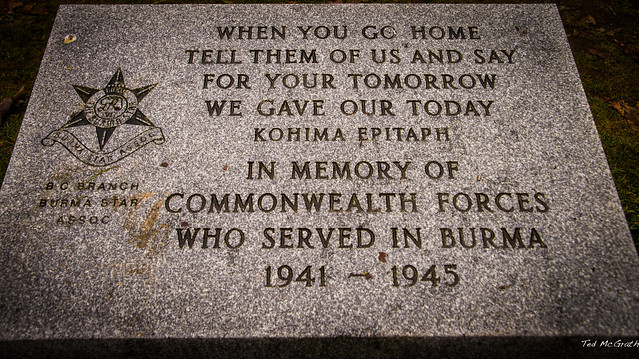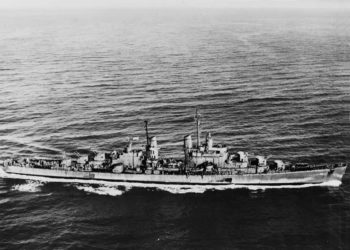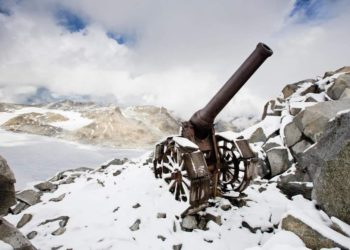One of the most sorely fought battles of the Second World War, was the fight for Kohima. Situated in North Eastern India, Kohima is a hill town in the middle of the Naga Hills. In those days, Kohima was an important hill station on the only road that led from the major British/Indian supply depot at Dimapur to Imphal.

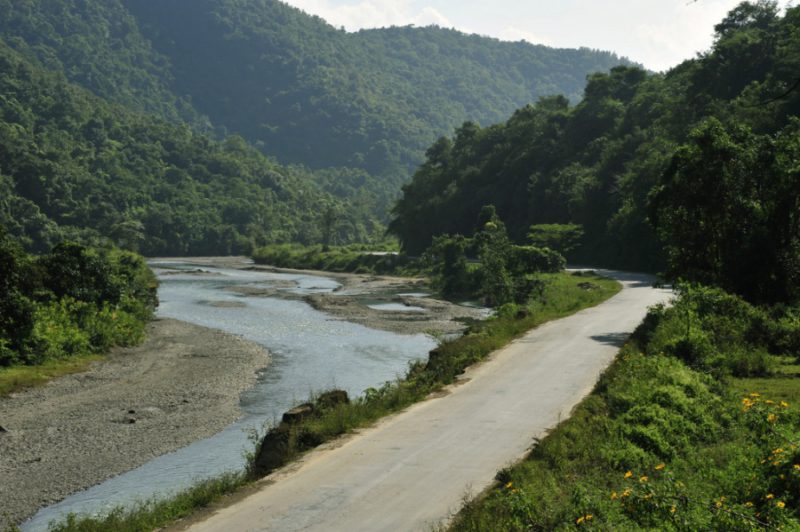
In 1943-44, under the command of General William Slim the British and Indian 14th Army over a course of 18 months built logistical bases in Dimapur and Imphal. An eventual attack into Burma was underway. In early 1944, Lt. General Renya Mutaguchi had received orders to stop British preparations in the region (called Assam). This would be a part of the larger Operation “U-Go” under which the Japanese decided to capture important border towns of North East India. The 15th, 31st and the 33rd Divisions were readied to destroy Allied forces at Imphal, Naga Hills and Kohima.
The Japanese had planned to use 31st Division for enveloping Kohima from three different angles by splitting into three columns. The Kohima-Imphal road was also to be cut off.
In Mid March of the fateful year, 1944- Japanese kick started Operation “U-Go”. Most of the stationed British IV Corps was engaged in defending Imphal, and inevitably Kohima fell short of adequate troops. The 1st Assam Regiment in Kohima was forced to withdraw in lieu of continuous attacks in Imphal. To ease some, the British Intelligence assumed that no more than a few battalions of the Japanese would be able to traverse the ridge area that existed between the Chidwin river and Kohima. Soon, however -reports confirmed that an entire Division was on it’s way to Kohima. The only troops available in Kohima were a few units of Assam Rifles and Line of Communication troops. Gen. Slim knew reinforcements were required and called in the 5th (and later 7th) Indian Division by air. Both these units had rich, recent combat experience and were sent off to defend both Imphal and Kohima.
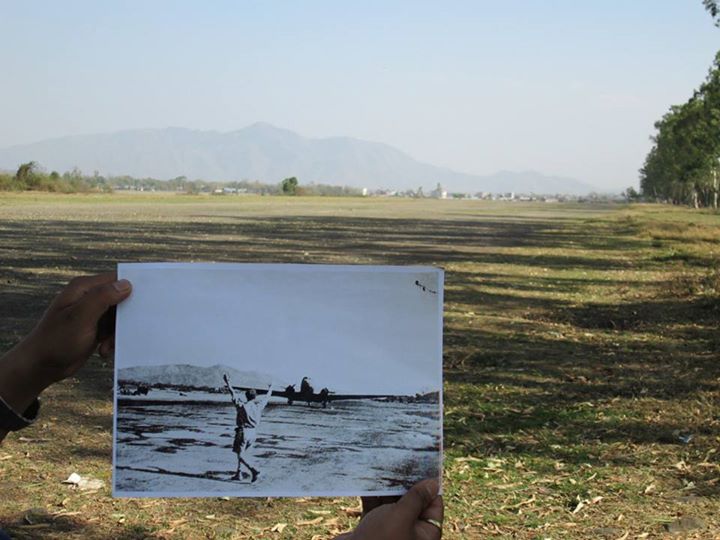
The Battle of Kohima can be divided into two phases:
- Ist Phase: Siege which lasted for 13 days
- 2nd Phase: Clearance of Japanese 31st Division from the area followed by opening of Kohima-Imphal road from Mid April to 22 June. More casualties were recorded in this phase.
The Siege
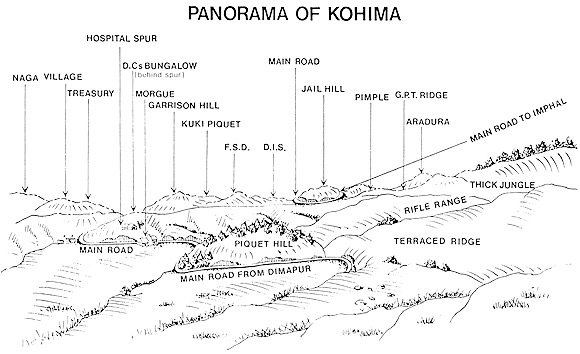
The sequence of events began from 5th of April, 1944. By this day, the 4th Royal West Kents and the remnants of the 161st Brigade had taken up positions in and around Kohima. The 4th Kents, with supporting elements from the Assam Rifles and Assam Regiment took up defensive stance at important locations along the Kohima Ridge. The Ridge consisted of features like Garrison Hill, Jail Hill, Field Supply Depot (FSD) and Detail Issue Hill (DIS). These areas along with the Deputy Commissioner’s (DC) Bungalow were the main lines of defense.
The attack of about 12,000 men of the Japanese 31st Division began in the evening on the same day. The 4th Kents, realizing their utter numerical inferiority decided to shorten their defenses. After the first attack, the troops withdrew from isolated positions along the ridge. With the induction of a vacuum, the Japanese made several inroads into the ridge and set up defensive positions. Morale among the defenders was boasted when reinforcements from Rajput Regiment arrived from a Jotsoma (nearby village) by 7th April. The Japanese rampage continued as more and more areas were lost, and the Allied forces kept retreating finally to the Tennis Court at DC’s Bungalow by 9th April. The Japanese had by then cut off the road between Kohima and Jotsoma; and also between Dimapur and Jotsoma. To add to the mayhem, further attacks resulted in the Garrison at Kohima to move back to FSD and DIS (10th/11th April). However, it would be erroneous to believe that British/Indians were not giving back a fight. It is a fact that the Japanese took heavy casualties every day but the sheer numbers they possessed overshadowed their losses.

Then came the infamously known, Battle of the Tennis Court..
The Tennis Court was in the middle of the ridge, and was being defended by the 4th Royal West Kents. On 13th April, the Japanese pressed their advantage onto DC’s Bungalow and Tennis Court-and all hell broke loose. It all began with murderous Artillery and Mortar fire, which refused to die out. There were frequent infantry assaults and this area was the scene of some of the hardest, grimmest and closest battles with grenades flying at point-blank range. Excerpts from the War Diary of 4th Kents:
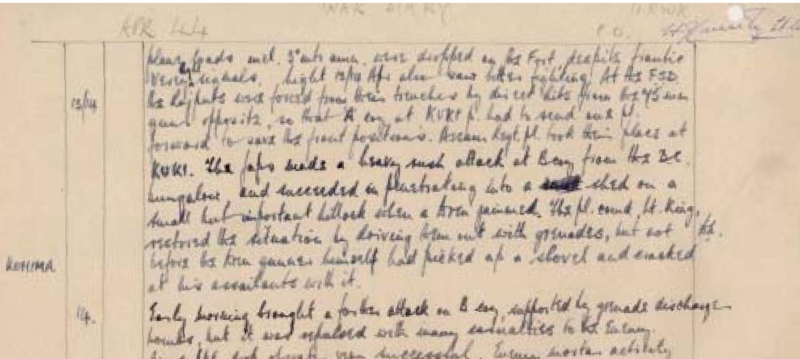
KOHIMA, April 13/14
Night 13/14 Apr also saw bitter fighting. At the FSD the Rajputs were forced from their trenches by direct hits from the 75mm guns opposite, so that A Coy at KUKI p. had to send one pl. forward to save the front positions….The Japs made a heavy rush attack at B Coy from the DC bungalow, and succeeded in penetrating into a shed on a small but important hillock when a Bren jammed.
The pln. comd, Lt King, restored the situation by driving them out with grenades, but not before the Bren gunner himself picked up a shovel and cracked at his assailants with it.
April 14
Early morning brought a further attack on B Coy, supported by grenade discharge bombs, but it was repulsed with many casualties to the enemy. Air supply drop of water very successful. Enemy mortar activity continued throughout the day, interspersed with smoke bombs which was taken to mean that his stock of captured ammunition was running low. This assumption was correct.
Water was scarce and the men had restricted themselves to one pint a day. “No shaving!“, the Officer would tell his boys. Forward trenches ran out of ammunition every now and then-Seargent Williams who later won the Military Cross resupplied repeatedly with no regard of his safety. Air drops were not always as accurate, as mentioned in the Diary entry. The terrain being unfavorable, it was more than once that Japanese received these supplies.
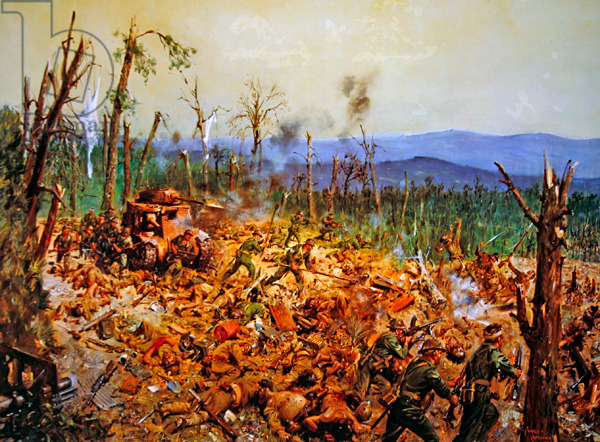
Copyright: Bridgeman images
Zero Cool fire from the Royal Artillery on the Jotsoma ridge gave support to the defenders and the attacks were repelled back. The Japanese Commanders were well aware of this and began directing their ingress towards Jotsoma. These too were given a cold shoulder and fought off.
April 14th can arguably be called as the turning point of the siege. While the Japanese continued to shell Kohima and Jotsoma garrisons, they did not send any infantry attacks. In the meanwhile 2nd Division reinforced British/Indian positions. After travelling a 1,500 mile distance by land and air, the 2nd Division along with 161st Brigade cleared the Japanese road block on Kohima-Dimapur road. Word of this reached the Kohima garrison on 15th-morale soared. Good news spread like wild fire–the lifting of the siege was inevitable and fast approaching. The Japanese knew they were running out of time as the 2nd Division was approaching.

They launched a final, deadly and desperate attack on the Field Supply Depot positions in the evening of 15/16 April. Domination of FSD exchanged hands more than once. Allied forces owing to heavy casualties, had to retreat to Garrison Hill. They were now hemmed in from South, North and East. Situation had turned horrid again.
With matters reaching crisis point, it was only about time that elements of 2nd Division, 161st Brigade and Lee Grant Tanks from XXXIII Corps jolted in and removed the Japanese from their positions supported by Royal Artillery fire. The road from Dimapur to Kohima being opened, the siege was finally declared lifted.
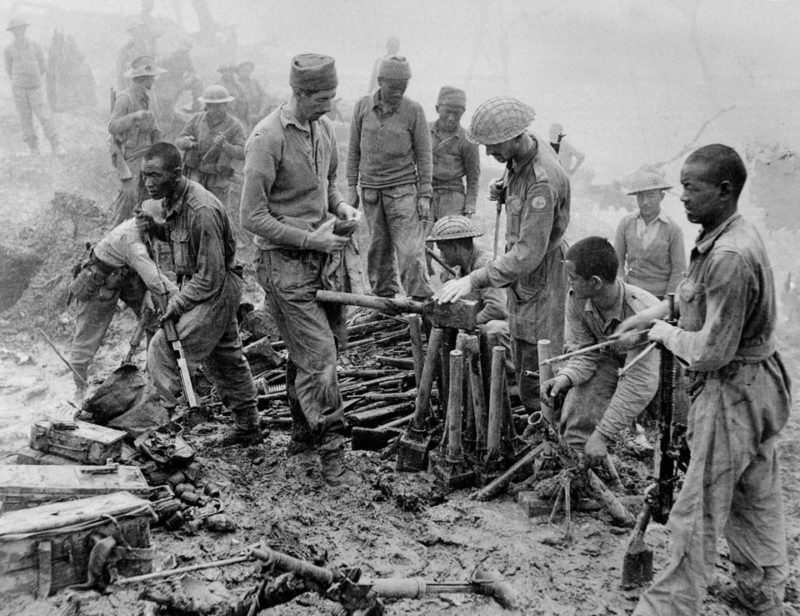
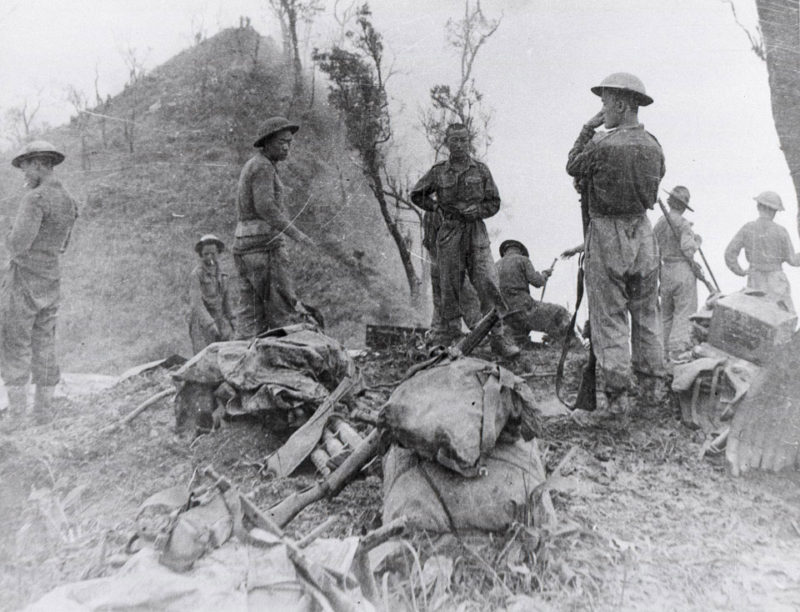
The Relief and Clearance of Kohima
Prima facie, yes the siege was removed. But the battle hardy Japanese hadn’t moved back just yet. In fact, a series of counter attacks began in May. The 2nd Division with 33rd and 161st Brigade were tasked to taking out remaining Japanese forces stationed around Kohima-and thus clear the road to Imphal. Again, the terrain and climate made this a laborious task. Lieutenant Horner, a signals officer described:
The physical hammering one takes is difficult to understand. The heat, humidity, altitude and the slope of almost every foot of ground combine to knock hell out of the stoutest constitution. You gasp for air which doesn’t seem to come, you drag your legs upwards till they seem reduced to the strength of matchsticks, you wipe the sweat out of your eyes… So you stop, horrified to be prodded by the man behind you or cursed by an officer in front.
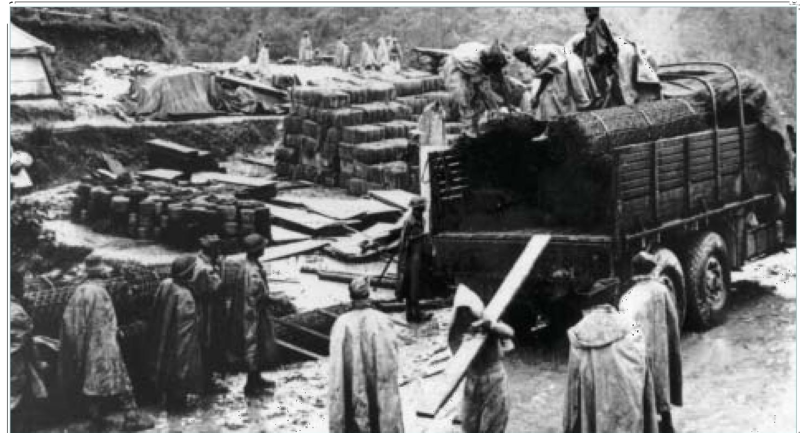
Clearing the north-east of Kohima went to 5th Infantry Brigade and remaining brigade of the 2nd Division, the 6th were entrusted with clearing the center, FSD Hill and Jail Hill. Fighting was documented by Major Boshell of ‘B’ Company, 1st Royal Berkshires, 6th Infantry Brigade:
To begin with I took over an area overlooking the Tennis Court… The lie of the land made it impossible to move by day because of Japanese snipers. We were in Kohima for three weeks. We were attacked every single night… They came in waves, it was like a pigeon shoot. Most nights they overran part of the battalion position, so we had to mount counter-attacks…..My company went into Kohima over 100 strong and came out at about 60.
The battle was unyielding, tough and extremely difficult with the Japanese putting up a stiff resistance. Arthur Swinson, a distinguished Historian of Kohima wrote:
7th May and the three days that followed were probably the bitterest time in the whole battle of Kohima. After thirty-four days and nights of close and bloody fighting, after hunger, thirst, discomfort, after appalling casualties, the enemy still held the main bastions of their position. No bombs, shells, mortars, flame-throwers or grenades could seem to shift them…The Jap[anese] had lost thousands upon thousands of men, and reports kept saying they were weak and diseased and running short of ammunition. But all the British, Gurkhas and Indians knew was that as soon as they got near a bunker, the fire poured out of it as mercilessly as ever.
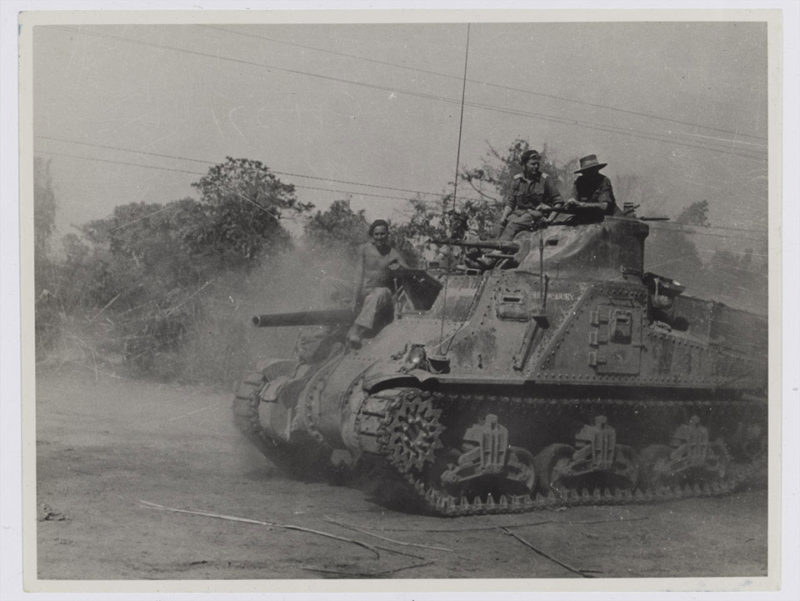
By 13th May, most features had been taken by British/Indian forces. A few however, including DC’s Bungalow were holding out against the Dorsets and their supporting tanks. Major Michael Lowry aptly described the scene:
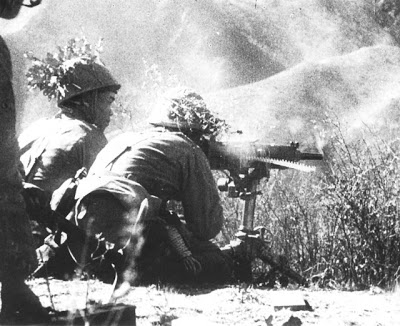
After this there followed a sniping duel, and then things happened the like of which I had never seen before. It was the nearest approach to a snowball fight that could be imagined. The air became thick with grenades, both theirs and ours, and we were all scurrying about trying to avoid them as they burst. This duel appeared to go on non-stop for an unreckonable time…
Over time, British and Indian forces began to gain an upper hand and the Japanese started to back the 31st Division starting Mid May. On 31st May, General Sato, Commander of 31st Division while ordering withdrawal said:
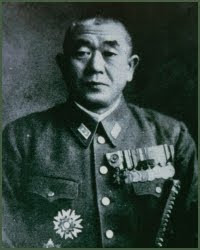
We fought for two months with the utmost courage and have reached the limits of human fortitudes… Shedding bitter tears I now leave Kohima.
As Japanese troops were cleared, more and more reinforcements from the XXXIII Corps made way for a complete victory. Strengthened, the 2nd Division mounted it’s final attack to clear the Kohima Imphal road and were again met with a ferocious enemy.
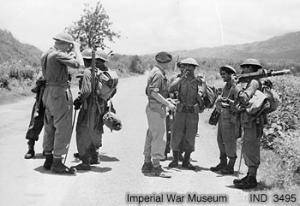
Eventually, the road was cleared and troops from Kohima and Imphal met at Milestone 110. What a joyous day it must have been, one can only imagine.
All in all, the British and Indian forces had lost about 4,000 men-KIA, missing and wounded. The Japanese, had lost more than 7,000 men in the Battle for Kohima.
Kohima today
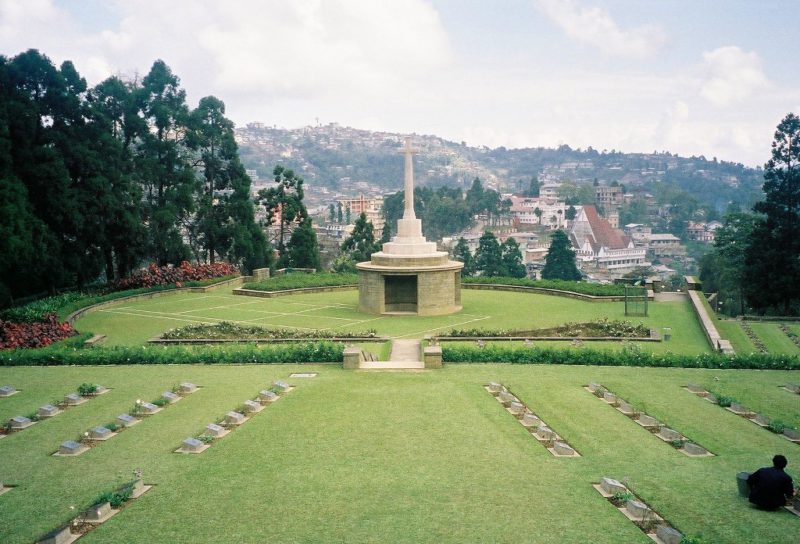
When You Go Home, Tell Them Of Us And Say, For Your Tomorrow, We Gave Our Today This is the epitaph carved on the memorial of the 2nd Division in Kohima Cemetery. Kohima today is still a quaint little town, with a population of about 100,000. It is still remote, with barely any connectivity and thus has been able to preserve it’s uniqueness. Roads are dusty, nobody seems to be in a hurry-pets run wild and so do the children. The views are breathtaking, the evenings even more picturesque. Relics of the great battle can still be found. The Kohima Cemetery lies in the background of Garrison Hill. The Deputy Commissioner’s House did not survive the battle. The Tennis Court too is nowhere to be found, however concrete lines mark it’s location. The completely terraced Cemetery contains 1420 CommonwealthBurials in all, all belonging to the Second World War. At the highest point is the Kohima Cremation memorial, which commemorates the 917 Hindu and Sikh soldiers who fought shoulder to shoulder with their British counterparts as part of the British Indian Army. Their remains are cremated in accordance of their faith. Near the entrance is a massive stone- a memorial to the contribution of the 2nd Division. This structure was dragged by Naga tribesmen to its present location.

When soldiers returned 10 years later to Kohima, they penned down their thoughts in the visitors book. “Impressive”, “A fitting resting place for heroes” among others were inked. But one ex-servicemen wrote this: “I wish my name were here”
